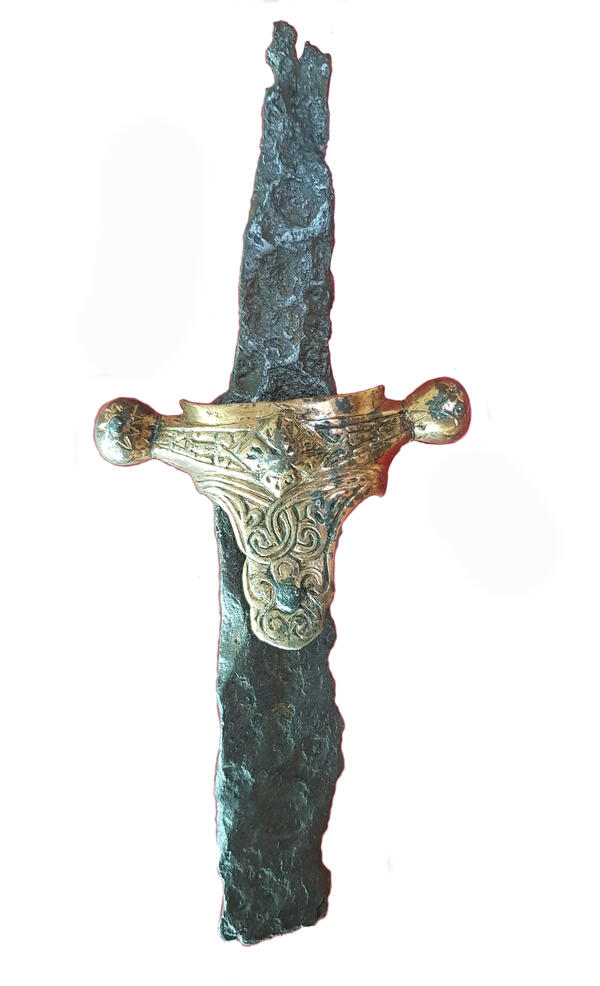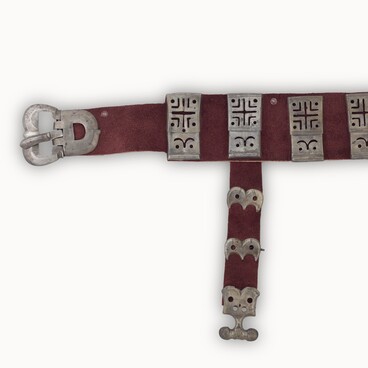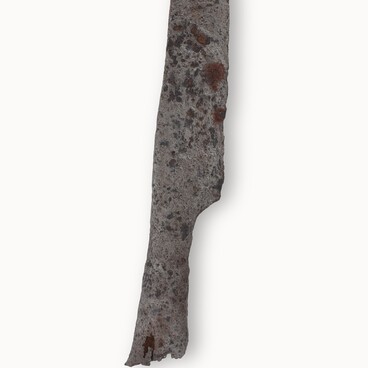During the excavations of Gochevsky archaeological complex (Kursk region) in 1909, the archaeologist Dmitry Yakovlevich Samokvasov in mound No. 1 found an ancient bladed weapon — a fragment of an iron sword (a palash).
According to the description in the excavation log book, it was “a straight saber of 1 arshin 7 vershoks long (1.02 m), with a decomposed wooden hilt, a knob decorated with a bronze pattern, in a scabbard with an iron bolster and two bronze patterned plaques”. The saber was laid along the right side of the buried warrior, from shoulder to knee. The rings with which the weapon was fastened to the cross-belt were also preserved.
The archaeologist and expert on medieval weaponry, Anatoly Nikolayevich Kirpichnikov, described this weapon as an early example of a saber, with the crossguard as type IB, and the pommel as type II. This shape was not used later than the 11th century. However, the Kursk historian and archaeologist Alexander Vasilievich Zorin reasonably noted that the description and images provided by Dmitry Samokvasov are very different from those offered by Anatoly Kirpichnikov and the researchers drawing from his work. First of all it concerns the degree of blade curvature, position of the crossguard, and the turn of the hilt. In the drawings of the scientific publications “Journal of excavations in the vicinity of the Gochevo village, Oboyansk district, Kursk province” and “Atlas of Gochevo antiquities, ” which were prepared with the participation of Dmitry Samokvasov, in accordance with the description in the text a palash (rather than a saber) is depicted — a straight single-blade 3 cm wide, with straight hilt and two chased bronze plaques, which decorated the throat of the wooden scabbard. The plaques were fastened to each other and to the scabbard with iron rivets.
It should be noted that this type of bladed weapons has a number of analogues in the war graves of the 10th century: in the burials of the Dmitrievsky burial ground of the Saltovo-Mayaki culture (the archaeological culture of the Iron Age in southern Russia and south-eastern Ukraine of the mid-8th — early 10th centuries), in the mounds of Shestovichy (an archaeological complex in Ukraine) where members of noblemen’s retinue were buried and in Malyshev burial ground, left by Muroma people (a Finno-Ugric tribe from the mid-1st millennium AD). The spread of such straight single-blade swords among noble cavalry men in the tribes of the left bank of the Dnieper is associated with the influence of the Khazar Khaganate, which kept a number of the East Slavic tribal unions in political dependence.
According to the description in the excavation log book, it was “a straight saber of 1 arshin 7 vershoks long (1.02 m), with a decomposed wooden hilt, a knob decorated with a bronze pattern, in a scabbard with an iron bolster and two bronze patterned plaques”. The saber was laid along the right side of the buried warrior, from shoulder to knee. The rings with which the weapon was fastened to the cross-belt were also preserved.
The archaeologist and expert on medieval weaponry, Anatoly Nikolayevich Kirpichnikov, described this weapon as an early example of a saber, with the crossguard as type IB, and the pommel as type II. This shape was not used later than the 11th century. However, the Kursk historian and archaeologist Alexander Vasilievich Zorin reasonably noted that the description and images provided by Dmitry Samokvasov are very different from those offered by Anatoly Kirpichnikov and the researchers drawing from his work. First of all it concerns the degree of blade curvature, position of the crossguard, and the turn of the hilt. In the drawings of the scientific publications “Journal of excavations in the vicinity of the Gochevo village, Oboyansk district, Kursk province” and “Atlas of Gochevo antiquities, ” which were prepared with the participation of Dmitry Samokvasov, in accordance with the description in the text a palash (rather than a saber) is depicted — a straight single-blade 3 cm wide, with straight hilt and two chased bronze plaques, which decorated the throat of the wooden scabbard. The plaques were fastened to each other and to the scabbard with iron rivets.
It should be noted that this type of bladed weapons has a number of analogues in the war graves of the 10th century: in the burials of the Dmitrievsky burial ground of the Saltovo-Mayaki culture (the archaeological culture of the Iron Age in southern Russia and south-eastern Ukraine of the mid-8th — early 10th centuries), in the mounds of Shestovichy (an archaeological complex in Ukraine) where members of noblemen’s retinue were buried and in Malyshev burial ground, left by Muroma people (a Finno-Ugric tribe from the mid-1st millennium AD). The spread of such straight single-blade swords among noble cavalry men in the tribes of the left bank of the Dnieper is associated with the influence of the Khazar Khaganate, which kept a number of the East Slavic tribal unions in political dependence.








